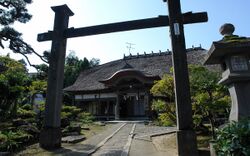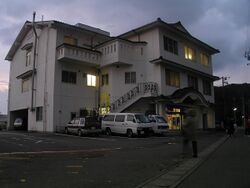Religion:Shukubo
A shukubo (宿坊) is a temple lodging in Japan that allows visitors to stay overnight within a Buddhist temple.[1] Originally, these facilities were designed to accommodate only monks and worshippers, but nowadays, in response to declining numbers of monk visitors, most facilities accept general tourists.[2] Some temples, such as Mount Kōya, have open-air baths with onsen.[3] Shukubo are now considered semi-secularized and in many towns are the only accommodations available.[3]
History
Originally, shukubo were used by bhikku and confraternities,[2][failed verification] and later by lay practitioners of Shugendō and mountain worship, and played major roles in the development of the latter two.[4] At the foot of Mount Haguro there were once 336 shukubo all linked to Shugendō.[5]
Networks of shukubo began[when?] to develop in Ise, Shima, Toba, and Futami-ura in a decades long construction boom.[6]
In the Edo period, visits to temples and shrines became popular, including visits to Ise, Kotohira-gū, and Zenkō-ji. Lodging houses were built at major temples and shrines in each area to accommodate ordinary pilgrims and tourists, forming a kind of tourism business, with specific areas connected to specific lodging houses.[3]
In modern times, some shukubo have been converted into traditional inns and ryokan for tourists who want to experience the atmosphere of a temple.[7][failed verification] Many modern-day operators of shukobo are descendants of families that ran shukubo when they were a purely religious matter. Originally, they only operated for one kosha but opening to the general public has substantially increased amounts of people staying at shukubo.[2]
Gallery
See also
- Shikoku Pilgrimage
- Mount Kōya
- Three Mountains of Dewa
- Mount Mitake (Tokyo)
References
- ↑ Earhart, H. Byron (1968). "The Celebration of "Haru-Yama" (Spring Mountain): An Example of Folk Religious Practices in Contemporary Japan". Asian Folklore Studies 27 (1): 1–24. doi:10.2307/1177798. https://www.jstor.org/stable/1177798.
- ↑ Jump up to: 2.0 2.1 2.2 Carter, C. (2018). "Power Spots and the Charged Landscape of Shinto". Japanese Journal of Religious Studies 45 (1): 145–174. doi:10.18874/jjrs.45.1.2018.145-173.
- ↑ Jump up to: 3.0 3.1 3.2 Reader, Ian (2020). "Turning to Tourism in a Time of Crisis?: Buddhist Temples and Pilgrimage Promotion in Secular(ized) Japan". Buddhist Tourism in Asia. University of Hawai’i Press. pp. 161–80. doi:10.2307/j.ctvgs09c4.13.
- ↑ Kaminishi, I. (2006). "Deciphering Mountain Worship". Explaining Pictures: Buddhist Propaganda and Etoki Storytelling in Japan. University of Hawai’i Press. pp. 165–192. ISBN 9780824826970.
- ↑ Earhart, H. B. (1965). "Four Ritual Periods of Haguro Shugendō in Northeastern Japan". History of Religions 5 (1): 93–113. doi:10.1086/462516.
- ↑ Andreeva, A. (2017). "From Ise to Miwa and Beyond". Assembling Shinto: Buddhist Approaches to Kami Worship in Medieval Japan. 396. Harvard University Asia Center. pp. 175–214. doi:10.2307/j.ctv47w8vp.12. ISBN 9781684175710.
- ↑ デジタル大辞泉,世界大百科事典内言及. "宿坊(シュクボウ)とは? 意味や使い方" (in ja). https://kotobank.jp/word/%E5%AE%BF%E5%9D%8A-528310.
External links
 |







